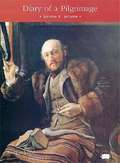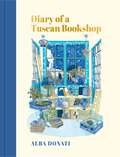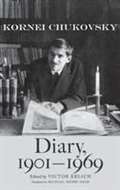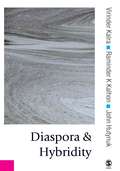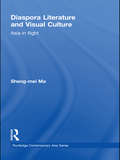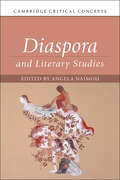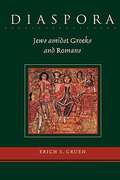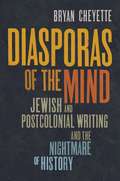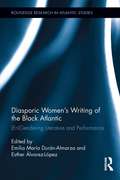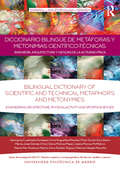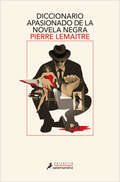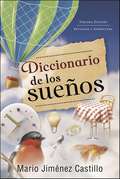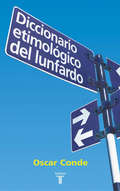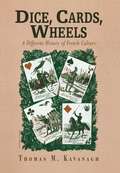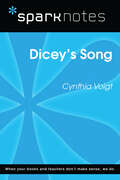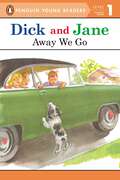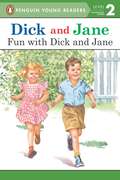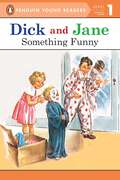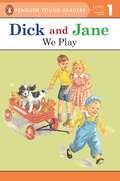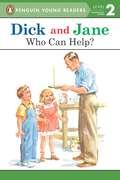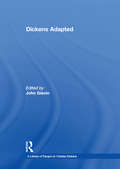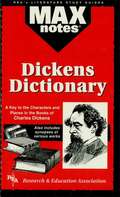- Table View
- List View
Diary of a Pilgrimage
by Jerome K. JeromeThis is a sensible book. I want you to understand that. This is a book to improve your mind. In this book I tell you all about Germany--at all events, all I know about Germany--and the Ober-Ammergau Passion Play. I also tell you about other things. I do not tell you all I know about all these other things, because I do not want to swamp you with knowledge. I wish to lead you gradually. When you have learnt this book, you can come again, and I will tell you some more.
Diary of a Tuscan Bookshop: The heartwarming story that inspired a nation, now an international bestseller
by Alba DonatiHOW A BOOKSELLER INSPIRED A NATIONThe diary of a publicist-turned bookseller who left Florence to open a tiny bookshop on a Tuscan hill. 'A work of significant beauty... Inspiring about the continuing life of books, and about the ways in which our lives can change and our dreams can come true, if only we insist on believing in changes and dreams'Michael Cunningham, author of The Hours'Romano, I'd like to open a bookshop where I live.''Right. How many people are we talking about?''A hundred and eighty.''Right, so if a hundred and eighty thousand people live there, then . . .''No, not hundred and eighty thousand, Romano. Just a hundred and eighty.''Alba . . . Have you lost your mind?'Conversation between Alba Donati and Romano Montroni, founder of Italy's largest bookselling chainAlba used to live a hectic life, working as a book publicist in Florence - a life that made her happy and led her to meet prominent international authors. And yet, she always felt like she was a woman on the run.And so one day she decides to stop running and go back to Lucignana, the small village on the Tuscan hills where she was born, to open a tiny bookshop.With a total of only 180 residents, Alba's enterprise in Lucignana seems doomed from day one but it surprisingly sparks the enthusiasm of many across Tuscany - and beyond. After surviving a fire and the restrictions imposed by the pandemic, the 'Bookshop on the Hill' soon becomes a refuge and beacon for an ever-growing community of people: readers who come to visit from afar, safe in the knowledge that Alba will be able to find the perfect book for them.A tale of resilience and entrepreneurship and a celebration of booksellers everywhere: the real (and often unsung) heroes of the publishing world.
Diary of a Young Girl (SparkNotes Literature Guide Series)
by SparkNotesDiary of a Young Girl (SparkNotes Literature Guide) by Anne Frank Making the reading experience fun! Created by Harvard students for students everywhere, SparkNotes is a new breed of study guide: smarter, better, faster.Geared to what today's students need to know, SparkNotes provides:chapter-by-chapter analysis explanations of key themes, motifs, and symbols a review quiz and essay topics Lively and accessible, these guides are perfect for late-night studying and writing papers.
Diary, 1901-1969
by Michael Henry Heim Kornei Chukovsky Victor Erlich Elena ChukovskayaA perceptive literary critic, a world-famous writer of witty and playful verses for children, a leading authority on children's linguistic creativity, and a highly skilled translator, Kornei Chukovsky was a complete man of letters. As benefactor to many writers including Alexander Solzhenitsyn and Joseph Brodsky, he stood for several decades at the center of the Russian literary milieu. It is no exaggeration to claim that Chukovsky knew everyone involved in shaping the course of twentieth-century Russian literature. His voluminous diary, here translated into English for the first time, begins in prerevolutionary Russia and spans nearly the entire Soviet era. It is the candid commentary of a brilliant observer who documents fifty years of Soviet literary activity and the personal predicament of the writer under a totalitarian regime. From descriptions of friendship with such major literary figures as Anna Akhmatova and Isaac Babel to accounts of the struggle with obtuse and hostile censorship, from the heartbreaking story of the death of the daughter who had inspired so many stories to candid political statements, the extraordinary diary of Kornei Chukovsky is a unique account of the twentieth-century Russian experience.
Diaspora & Hybridity (Published in association with Theory, Culture & Society)
by Virinder S. Kalra Raminder Kaur John Hutnyk'Diaspora & Hybridity deals with those theoretical issues which concern social theory and social change in the new millennium. The volume provides a refreshing, critical and illuminating analysis of concepts of diaspora and hybridity and their impact on multi-ethnic and multi-cultural societies' - Dr Rohit Barot, Department of Archaeology and Anthropology, University of Bristol What do we mean by 'diaspora' and 'hybridity'? Why are they pivotal concepts in contemporary debates on race, culture and society? This book is an exhaustive, politically inflected, assessment of the key debates on diaspora and hybridity. It relates the topics to contemporary social struggles and cultural contexts, providing the reader with a framework to evaluate and displace the key ideological arguments, theories and narratives deployed in culturalist academic circles today. The authors demonstrate how diaspora and hybridity serve as problematic tools, cutting across traditional boundaries of nations and groups, where trans-national spaces for a range of contested cultural, political and economic outcomes might arise. Wide ranging, richly illustrated and challenging, it will be of interest to students of cultural studies, sociology, ethnicity and nationalism.
Diaspora Literature and Visual Culture: Asia in Flight (Routledge Contemporary Asia Series)
by Sheng-mei MaThis book offers an incisive and ambitious critique of Asian Diaspora culture, looking specifically at literature and visual popular culture. Sheng-mei Ma’s engaging text discusses issues of self and its relationship with Asian Diaspora culture in the global twenty-first century. Using examples from Asia, Asian America, and Asian Diaspora from the West, the book weaves a narrative that challenges the twenty-first century triumphal discourse of Asia and argues that given the long shadow cast across modern film and literature, this upward mobility is inescapably escapist, a flight from itself; Asia’s stunning self-transformation is haunted by self-alienation. The chapters discuss a wealth of topics, including Asianness, Orientalism, and Asian American identity, drawing on a variety of pop culture sources from The Matrix Trilogy to Crouching Tiger, Hidden Dragon. This book forms an analysis of the new idea of Asian Diaspora that cuts across area, ethnicity, and nation, incorporating itself into the contemporary global culture whilst retaining a distinct Asian flavor. Covering the mediums of literature, film, and visual cultures, this book will be of immense interest to scholars and students of Asian studies and literature, ethnic studies, cultural studies, and film.
Diaspora and Literary Studies (Cambridge Critical Concepts)
by Angela NaimouDiaspora is an ancient term that gained broad new significance in the twentieth century. At its simplest, diaspora refers to the geographic dispersion of a people from a common originary space to other sites. It pulls together ideas of people, movement, memory, and home, but also troubles them. In this volume, established and newer scholars provide fresh explorations of diaspora for twenty-first century literary studies. The volume re-examines major diaspora origin stories, theorizes diaspora through its conceptual intimacies and entanglements, and analyzes literary and visual-cultural texts to reimagine the genres, genders, and genealogies of diaspora. Literary mappings move across Africa, the Americas, Middle East, Asia, Europe, and Pacific Islands, and through Atlantic, Pacific, Mediterranean, Gulf, and Indian waters. Chapters reflect on diaspora as a key concept for migration, postcolonial, global comparative race, environmental, gender, and queer studies. The volume is thus an accessible and provocative account of diaspora as a vital resource for literary studies in a bordered world.
Diaspora: Jews amidst Greeks and Romans
by Erich S. GruenThe book reminds us there was a time in history when there was no anti-Semitism. Its virulent strain only broke out in the terrible race riot in Alexandria of 38 CE, when the Romans were already ruling the city and the Jews and the Egyptians were vying for their favor--and their jobs. The author explores the lives of these Jews, the obstacles they encountered, the institutions they established, and their strategies for adjustment. He also delves into Jewish writing in this period.
Diasporas of the Mind
by Bryan CheyetteIn this fascinating and erudite book, Bryan Cheyette throws new light on a wide range of modern and contemporary writers--some at the heart of the canon, others more marginal--to explore the power and limitations of the diasporic imagination after the Second World War. Moving from early responses to the death camps and decolonization, through internationally prominent literature after the Second World War, the book culminates in fresh engagements with contemporary Jewish, post-ethnic, and postcolonial writers. Cheyette regards many of the twentieth- and twenty-first-century luminaries he examines--among them Hannah Arendt, Anita Desai, Frantz Fanon, Albert Memmi, Primo Levi, Caryl Phillips, Philip Roth, Salman Rushdie, Edward Said, Zadie Smith, and Muriel Spark--as critical exemplars of the diasporic imagination. Against the discrete disciplinary thinking of the academy, he elaborates and argues for a new comparative approach across Jewish and postcolonial histories and literatures. And in so doing, Cheyette illuminates the ways in which histories and cultures can be imagined across national and communal boundaries.
Diasporic Women's Writing of the Black Atlantic: (En)Gendering Literature and Performance
by Emilia María Durán-Almarza Esther Álvarez-LópezThis book brings together a complete set of approaches to works by female authors that articulate the black Atlantic in relation to the interplay of race, class, and gender. The chapters provide the grounds to (en)gender a more complex understanding of the scattered geographies of the African diaspora in the Atlantic basin. The variety of approaches displayed bears witness to the vitality of a field that, over the years, has become a diasporic formation itself as it incorporates critical insights and theoretical frameworks from multiple disciplines in the social sciences and the humanities, thus exposing the manifold character of (black) diasporic interconnections within and beyond the Atlantic. Focusing on a wide array of contemporary literary and performance texts by women writers and performers from diverse locations including the Caribbean, Canada, Africa, the US, and the UK, chapters visit genres such as performance art, the novel, science fiction, short stories, and music. For these purposes, the volume is organized around two significant dimensions of diasporas: on the one hand, the material—corporeal and spatial—locations where those displacements associated with travel and exile occur, and, on the other, the fluid environments and networks that connect distant places, cultures, and times. This collection explores the ways in which women of African descent shape the cultures and histories in the modern, colonial, and postcolonial Atlantic worlds.
Diccionario Bilingüe de Metáforas y Metonimias Científico-Técnicas: Ingeniería, Arquitectura y Ciencias de la Actividad Física
by Georgina Cuadrado EsclapezDiccionario Bilingüe de Metáforas y Metonimias Científico-Técnicas presents the extensive range of metaphoric and metonymic terms and expressions that are commonly used within the fields of science, engineering, architecture and sports science. Compiled by a team of linguists working across a range of technical schools within the Universidad Politécnica de Madrid, this practical dictionary fills a gap in the field of technical language and will be an indispensable reference for students within the fields of science, engineering or sports science seeking to work internationally and for translators and interpreters working in these specialist fields.
Diccionario apasionado de la novela negra
by Pierre LemaitreUna visión completa, absolutamente personal y muy divertida del género negro, por uno de los escritores europeos más prestigiosos y populares. Se la llame negra o policiaca, y se la califique o no «literatura de género» --como si no fuera literatura sin más--, la novela criminal tiene súbditos, reyes, reinas (supuestos o no), capillas, polémicas, egos... pero, sobre todo, novelas que atrapan, impactan, sobrecogen y marcan tanto mentes como épocas. Incondicional de los libros, las películas y las series que describen --o denuncian-- la (mala) marcha del mundo, Pierre Lemaitre, con la libertad, el compromiso y la vivacidad que lo caracterizan, dibuja un panorama internacional personal y divertido, cual biblia erudita, ecléctica y festiva de la novela negra. La crítica ha dicho...«Con la ágil pluma que le conocemos, Pierre Lemaitre comparte en este Diccionario su pasión por la literatura policiaca y la novela negra con un subjetivismo entusiasta y razonado.»RTL «Pierre Lemaitre se apodera de la novela policiaca como novelista y lector, y ofrece su punto de vista con regocijo, asombro y placer. [...] Los aficionados a la novela negra disfrutarán enormemente con esta panorámica.»RTS culture «Uno de esos diccionarios por los que el lector se pasea a placer, antes de leerlo de cabo a rabo. Véanlo como una charla en torno al álbum de fotos de la familia o una invitación a descubrir todo lo que les quedaba por explorar en el continente del noir.»France Inter «Un libro imponente, rebosante de pasión por compartir, que alterna las declaraciones de amor con puyas muy sentidas. Una obra golosa que permite al aficionado, dependiendo de su apetito, devorarla o picar aquí y allá entre los retratos de escritores (de Eric Ambler a Don Winslow, pasando por Jean-Patrick Manchette, Elizabeth George, Donald Westlake y muchos otros) y las revisiones de personajes míticos (a Lemaitre le encanta Colombo), películas y series de referencia (Arresto preventivo, The Wire, etc.).»La Dépêche
Diccionario de los Suenos
by Mario Jimv©nez CastilloConozca el significado de sus sueñosTercera edición revisada y aumentadaEl sueño es una función vital que aligera la carga energética, psicológica y psíquica del cerebro durante su estado consciente. Se calcula que el ser humano sueña entre cuarenta y cincuenta mil horas a lo largo de su existencia, algo así como una novena parte de su vida.En el Diccionario de los sueños encontrará una breve recopilación de las teorías que fundamentan el saber moderno sobre el proceso biológico, las características y los beneficios del sueño, así como más de ocho mil interpretaciones incluyendo palabras poco comunes no encontradas en otros diccionarios.Aprenda el simbolismo contenido en sus sueños y descifre los mensajes que le ayudarán a tomar decisiones importantes en la vida, reconocer oportunidades de trabajo, encontrar el amor y hasta prevenir enfermedades.Discover one of the most complete dream dictionaries, designed to help you decipher all of your dreams—from the simplest to the most abstract. This book presents more than 8,000 dream interpretations, including rare and uncommon words not found in other sources. (This is a Spanish-language book.)
Diccionario etimológico del lunfardo
by Oscar CondeEdición corregida y aumentada. Este diccionario de lunfardo, con casi seis mil entradas, es el único que da cuenta de la etimología de los vocablos y resulta incomparable por su rigor científico, lo que redunda en una mayor claridad y facilita las búsquedas. La palabra lunfardo, que en su origen significó "ladrón" define un extenso vocabulario que nació en las ciudades rioplatenses y se extendió luego al resto del país y a las naciones limítrofes hasta instalarse definitivamente en nuestra habla cotidiana.Las palabras que usamos son mucho más que un medio de comunicación: en su conjunto reflejan un modo de ver el mundo, de categorizar la realidad, de entenderla, en suma, de vivirla. Y sólo nacen cuando el hablante no tiene otras mejores para expresar lo que quiere decir. Los lunfardismos no escapan a esta ley, y constituyen un potente caudal que enriquece nuestro idioma y contribuye de manera indiscutible a construir nuestra identidad. La presente edición, corregida y aumentada, incorpora nuevas acepciones de términos ya registrados y añade voces que no contaban con registro hasta la fecha, como cachengue, ladri, roche, tarlipes y viejazo, entre otras.
Dice, Cards, Wheels
by Thomas M. KavanaghGambling has been a practice central to many cultures throughout history. In Dice, Cards, Wheels, Thomas M. Kavanagh scrutinizes the changing face of the gambler in France over a period of eight centuries, using gambling and its representations in literature as a lens through which to observe French culture. Kavanagh argues that the way people gamble tells us something otherwise unrecognized about the values, conflicts, and cultures that define a period or class. To gamble is to enter a world traced out by the rules and protocols of the game the gambler plays. That world may be an alternative to the established order, but the shape and structure of the game reveal indirectly hidden tensions, fears, and prohibitions.Drawing on literature from the Middle Ages to the present, Kavanagh reconstructs the figure of the gambler and his evolving personae. He examines, among other examples, Bodel's dicing in a twelfth-century tavern for the conversion of the Muslim world; Pascal's post-Reformation redefinition of salvation as the gambler's prize; the aristocratic libertine's celebration of the bluff; and Balzac's, Barbey d'Aurevilly's, and Bourget's nineteenth-century revisions of the gambler.Dice, Cards, Wheels embraces the tremendous breadth of French history and emerges as a broad-ranging study of the different forms of gambling, from the dice games of the Middle Ages to the digital slot machines of the twenty-first century, and what those games tell us about French culture and history.
Dicey's Song (SparkNotes Literature Guide Series)
by SparkNotesDicey's Song (SparkNotes Literature Guide) by Cynthia Voigt Making the reading experience fun! Created by Harvard students for students everywhere, SparkNotes is a new breed of study guide: smarter, better, faster.Geared to what today's students need to know, SparkNotes provides:chapter-by-chapter analysis explanations of key themes, motifs, and symbols a review quiz and essay topics Lively and accessible, these guides are perfect for late-night studying and writing papers.
Dick and Jane: Away We Go (Dick and Jane #Vol. 7)
by Penguin Young ReadersSally said, "Away we go. Away we go in the car. Mother and Father. Dick an Jane. Sally and Tim"
Dick and Jane: Fun with Dick and Jane (Dick and Jane)
by Penguin Young Readers"Look, Jane, " said Dick. "Here is something funny. Can you guess what it is?"
Dick and Jane: Something Funny (Dick and Jane)
by Penguin Young ReadersDick and Jane see something funny. Come and see Spot! Have fun with Dick and Jane as you read along with this sweet and simple story.
Dick and Jane: We Play (Dick and Jane)
by Penguin Young ReadersDick can play. Jane can play. Spot can play, too! Have fun with Dick and Jane as you read along with this sweet and simple story.
Dick and Jane: Who Can Help? (Dick and Jane #Vol. 8)
by Penguin Young ReadersOh, Jane. Oh, Father. Who can come? Who can come and help me?
Dickens
by Fred KaplanKaplan (English, Queens College) provides a full-scale portrait of Dickens and incorporates into the narrative a discussion of the autobiographical basis and significance of his greatest masterpieces.
Dickens Adapted (A Library of Essays on Charles Dickens)
by John GlavinFrom their first appearance in print, Dickens's fictions immediately migrated into other media, and particularly, in his own time, to the stage. Since then Dickens has continuously, apparently inexhaustibly, functioned as the wellspring for a robust mini-industry, sourcing plays, films, television specials and series, operas, new novels and even miniature and model villages. If in his lifetime he was justly called 'The Inimitable', since his death he has become just the reverse: the Infinitely Imitable. The essays in this volume, all appearing within the past twenty years, cover the full spectrum of genres. Their major shared claim to attention is their break from earlier mimetic criteria - does the film follow the novel? - to take the new works seriously within their own generic and historical contexts. Collectively, they reveal an entirely 'other' Dickensian oeuvre, which ironically has perhaps made Dickens better known to an audience of non-readers than to those who know the books themselves.
Dickens Dictionary (MAXNotes Literature Guides)
by Editors of REA Alex PhillipsREA's MAXnotes Dickens Dictionary The MAXNotes Dickens Dictionary is your key to the places and characters in the books of Charles Dickens. This text includes synopses of each of Dickens's works, both major and minor, along with dictionary style entries referring to the body of work as a whole. A must for any student of Dickens.
Dickens Dictionary: An A-Z of England's Greatest Novelist
by John SutherlandFROM THE BOOK JACKET: For fans old and new, this is a fascinating tour through Charles Dickens's novels, in the hands of a master critic and -- interpreter of his work. Oliver Twist... Great Expectations... David Copperfield - all contain riotous fictional worlds that still live and breathe for readers today. But how much do we really know about the dazzling imagination that brought them all into being? To celebrate the bicentenary of the birth of Dickens in 2012, Victorian literature expert John Sutherland has created a gloriously wide-ranging alphabetical companion to Dickens's novels, excavating the hidden links between his characters, themes, and preoccupations, and the minutiae of his endlessly inventive wordplay.
